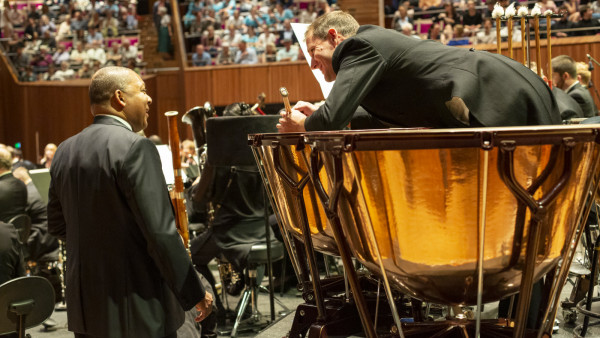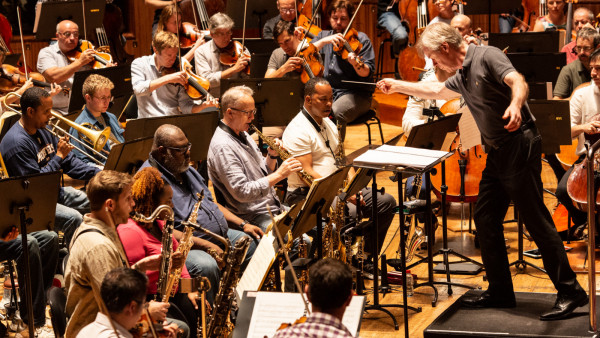Wynton Marsalis takes us on a Jungle prowl
New York is a helluva town and it features strongly in Sydney’s arts and entertainment scene at the moment with trumpet superstar Wynton Marsalis here leading his Jazz at Lincoln Center Orchestra for a series of concerts with the Sydney Symphony, and operagoers preparing for the open-air production of West Side Story in March.
Marsalis shows how easily he bestrides the genres of classical and jazz music with the first of these concerts, which features his fourth symphony, The Jungle, in an Australian premiere performance under the baton of SSO chief conductor and fellow American David Robertson.
This hour-long work is an homage to New York City — “the most fluid, pressure-packed and cosmopolitan metropolis the world has ever seen”, as Marsalis says.
It is in five movements and the 16-strong top-notch jazz band sits front stage surrounded by Sydney’s finest, who have shown on several occasions that they can swing if they have to.
Marsalis has already established himself as a modern-day Duke Ellington, capable to writing large format works which neatly cross the genres.
HISTORY
He first established himself as a world-beating trumpeter at 17 when he played with Art Blakey and the Messengers, going on to lead his own bands and making more than 60 recordings and picking up nine Grammies. He made history by taking out two in the same year — one for jazz and the other for his classical recording of the Haydn trumpet concertos — and repeating the feat in the following year.
He was here with the JLCO in 2016 performing his Swing Symphony — a musical journey through the history of jazz — and a one night concert of music by Duke Ellington and George Gershwin.
If anything this tour is even more impressive. Jungle Symphony traces the city’s DNA from the Native Americans (the opening movement The Big Scream — Black Elk Speaks) through the Jazz Age and European immigration to the enormous Latin-American influences and the manic stock market and business world.
But the most symphonic movement, Lost In Sight (Post Pastoral) is the most impressive and integrated, managing to meld Dvorak’s idealised pastoral impression of the New World Symphony largo with a colder, starker portrait of homelessness and those who can’t survive the bitter reality of the Big Apple.
Robertson opened the program with another view of New York, Ameriques, a work written by French-born composer Edgard Varese who arrived in the city bent of adventure and a new life after World War I.
Robertson told his mainly young audience they were right to be concerned to see a conductor with a microphone in his hand. “Over the next 22 minutes you’re going to hear the most extraordinary piece for orchestra,” he promised them.
RAUCOUS
He explained how Varese arrived in America “with a clean slate” after most of his music was lost in a fire in a Berlin warehouse.
“He arrived to the hustle and bustle of New York where anything’s possible at a time when science was making all these breakthroughs,” Robertson said.
Heavily influenced by Igor Stravinsky’s Rite of Spring, which had its premiered only a couple of years before, Ameriques is indeed a remarkable work in which Varese bends the lines between “music” and “noise”.
He wasn’t fond of strings, so they have a subsidiary role. It’s the huge percussion department, which includes a siren, xylophones and two sets of tubular bells, and the massed brass and woodwinds that do the heavy lifting. The result is spectacular. Raucous and cacophonous and vibrant with energy.
He explained how Varese arrived in America “with a clean slate” after most of his music was lost in a fire in a Berlin warehouse.
“He arrived to the hustle and bustle of New York where anything’s possible at a time when science was making all these breakthroughs,” Robertson said.
Heavily influenced by Igor Stravinsky’s Rite of Spring, which had its premiered only a couple of years before, Ameriques is indeed a remarkable work in which Varese bends the lines between “music” and “noise”.
He wasn’t fond of strings, so they have a subsidiary role. It’s the huge percussion department, which includes a siren, xylophones and two sets of tubular bells, and the massed brass and woodwinds that do the heavy lifting. The result is spectacular. Raucous and cacophonous and vibrant with energy.
The SSO have never played it before and probably never will again after this tour.
The schoolkids loved it.
The concert is repeated on Friday, February 22, at 8pm and on Monday, February 25, at 7pm at the Opera House Concert Hall. Marsalis and the JLCO will play Duke Ellington and Count Basie sets at the Sydney Opera House Concert Hall on Saturday, February 23, at 7pm.
Source: Daily Telegraph


